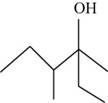
Concept explainers
(a)
Interpretation: The percent by mass of M in
Concept introduction: Grignard reagent is an
To determine: The percent by mass of M in
(a)
Answer to Problem 159IP
Answer
The mass percent of M in
Explanation of Solution
Explanation
Given
Electronic configuration of
So,
In periodic table atomic number is found to be of the element Zinc.
The molar mass of Zinc is
The molar mass of compound
The molar mass of carbon is
The molar mass of hydrogen is
The molar mass of Zinc is
The molar mass of Bromine is
The molar mass of compound
Therefore the total molar mass of compound
The mass percent of M in
Substitute the value of the molar mass of M and total molar mass of compound, to calculate percent by mass of M in
Therefore, the mass percent of M in
Conclusion
The mass percent of M in
(b)
Interpretation: The percent by mass of M in
Concept introduction: Grignard reagent is an organometallic compound which is prepared by treating magnesium or metal atom with a strong acid. The Grignard reaction is defined as an organometallic reaction in which the vinyl, alkyl and aryl-metal halides were added to a carbonyl carbon atom and form an aldehyde or ketone.
To determine: The hybridization of the starred carbon atom in the given figure changed from reactants to products.
(b)
Answer to Problem 159IP
Answer
The hybridization of the starred carbon atom shown in Figure 1 is changed from
Explanation of Solution
Explanation
The given reaction is,

Figure 1
In the given reaction the reactant contains carbonyl group having double bonded oxygen atom hence, the hybridization of the starred carbon in the reactant is
Conclusion
The hybridization of the starred carbon atom shown in Figure 1 is changed from
(c)
Interpretation: The percent by mass of M in
Concept introduction: Grignard reagent is an organometallic compound which is prepared by treating magnesium or metal atom with a strong acid. The Grignard reaction is defined as an organometallic reaction in which the vinyl, alkyl and aryl-metal halides were added to a carbonyl carbon atom and form an aldehyde or ketone.
To determine: The systematic name of the product.
(c)
Answer to Problem 159IP
Answer
The systematic name of the product is
Explanation of Solution
Explanation
The given compound is,

Figure 2
The longest carbon chain contains six carbon atoms numbered from the nearest
Conclusion
The systematic name of the product shown in Figure 2 is
Want to see more full solutions like this?
Chapter 22 Solutions
CHEMISTRY,AP EDITION-W/ACCESS (HS)
- can someone give a description of this NMR including whether its a triplt singlet doublet where the peak is around at ppm and what functional group it representsarrow_forward1. Determine the relationship between the following molecules as identical, diastereomers, or enantiomers (6 points, 2 points each). OH OH OH A-A OH HOT HO- ACHN and HO- ACHN OH HO HO ° OH and OH OH SH and ...SHarrow_forward20,0 Complete the electron pushing mechanism to y drawing the necomery unicaciones and carved on for Step 1: Add curved arms for the tint step, traiment with NalilĻ. The Nation 458 Step 2: Added for the second step, inalment with), how the "counterion bar Step 3: Daw the products of the last simplom organic and one incoganic spacient, including all nonbondingarrow_forward
- please provide the structure for this problem, thank you!arrow_forwardDraw the Fischer projection from the skeletal structure shown below. HO OH OH OH OH H Q Drawing Atoms, Bonds and Rings Charges I ☐ T HO H H OH HO I CH2OH H OH Drag H OH -CH2OH CHO -COOH Undo Reset Remove Donearrow_forwardplease provide the structure for this problem, thank youarrow_forward
- presented by Morallen Lig Intermine the hand product for the given mution by adding atoms, bonds, nonhonding diarion panda скуль Step 3: Comp the draw the product Step 2: Agama workup Compithe 429 ملولةarrow_forwardReaction A 0,0arrow_forwardpresented by Morillon Leaning Predict the organic product for the min кусур HSC Adithane carved arnown to come than that to the condon slchroruis in acid in in aquishri with ноюarrow_forward
- 6.15PM Sun Mar 30 K Draw the major product of this reaction. Include any relevant stereochemistry. Ignore inorganic byproducts. Problem 1 of O H [PhзPCH2CH3]*C|¯ NaH Drawing > Q Atoms, Bonds and Draw or tap a nearrow_forward8:17 PM Sun Mar 30 Draw the major product of this reaction. Ignore inorganic byproducts. HSCH2CH2CH2SH, BF3 Probler Drawing Ato Bonds Clarrow_forwardpresented by Mr L How the coprion. (Il Done in no wraction, dew the starting redential) доarrow_forward
 Chemistry for Engineering StudentsChemistryISBN:9781337398909Author:Lawrence S. Brown, Tom HolmePublisher:Cengage Learning
Chemistry for Engineering StudentsChemistryISBN:9781337398909Author:Lawrence S. Brown, Tom HolmePublisher:Cengage Learning Introductory Chemistry: A FoundationChemistryISBN:9781337399425Author:Steven S. Zumdahl, Donald J. DeCostePublisher:Cengage Learning
Introductory Chemistry: A FoundationChemistryISBN:9781337399425Author:Steven S. Zumdahl, Donald J. DeCostePublisher:Cengage Learning Organic ChemistryChemistryISBN:9781305580350Author:William H. Brown, Brent L. Iverson, Eric Anslyn, Christopher S. FootePublisher:Cengage Learning
Organic ChemistryChemistryISBN:9781305580350Author:William H. Brown, Brent L. Iverson, Eric Anslyn, Christopher S. FootePublisher:Cengage Learning Chemistry & Chemical ReactivityChemistryISBN:9781337399074Author:John C. Kotz, Paul M. Treichel, John Townsend, David TreichelPublisher:Cengage Learning
Chemistry & Chemical ReactivityChemistryISBN:9781337399074Author:John C. Kotz, Paul M. Treichel, John Townsend, David TreichelPublisher:Cengage Learning Chemistry & Chemical ReactivityChemistryISBN:9781133949640Author:John C. Kotz, Paul M. Treichel, John Townsend, David TreichelPublisher:Cengage Learning
Chemistry & Chemical ReactivityChemistryISBN:9781133949640Author:John C. Kotz, Paul M. Treichel, John Townsend, David TreichelPublisher:Cengage Learning




